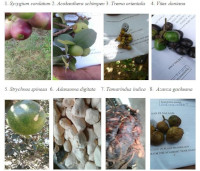Ethnomedicinal and antioxidant potentials of some wild fruits of Shinyanga region in Tanzania
Main Article Content
Abstract
Wild fruits are potentially natural foods, healthy and economically important in our communities. Lack of data on the nutritive and medicinal values of the wild fruits leave them neglected in our communities. Investigation on medicinal use and antioxidant potential of wild fruits in the drylands area of Shinyanga region was conducted in 2022 at Iselamagazi ward (33° 8'14.52"E to 33° 8'26.97"E and 3°32'28.44"S to 3°32'40.38"S) in Shinyanga rural District. Wild fruits were collected using standard methods from the purposely selected areas while ethnomedicinal information was collected using a questionnaire method. Extraction of plant material was done by solvent extraction method using ethanol 99.8% v/v as a solvent. Extract of the wild fruits were evaluated calorimetrically using the spectrophotometer UV-Visible model 6305 Jenway, UK. Ethnomedicinal information from the questionnaire were also collated. Antioxidant properties were obtained using 2, 2-diphenyl-1picrylhydrazyl DPPH) method. Results indicate that the wild fruits are potential natural antioxidants with total phenolic content (gallic acid equivalence) ranging from 19.513-175.983 mg GAE/g and total flavonoid content (Ruta graveolens) ranging from 9.171-176.99 mg RUE/g. Adansonia digitata showed the highest antioxidant capacity (175.983mg GAE/g) and Trema orientalis showed the lowest antioxidant capacity (17.898mg GAE/g). Scavenging ability values of the fruits ranged from 0.368-44.77 taurine (TAU) in total phenolic and 0.233-5.68 TAU in total flavonoid content. More than 20 diseases were reported to be treated by the investigated fruits based on ethnomedicinal information of the investigated community. Propagation and fruits utilization sensitization of the wild fruits in our communities will improve health and livelihood but also conserve our environments.
Downloads
Article Details

This work is licensed under a Creative Commons Attribution-NonCommercial-NoDerivatives 4.0 International License.
References
Battino, M. Giampieri, F. Pistollato, F. (2018). Nrf2 as regulator of innate immunity: A molecular Swiss army knife. Biotechnology Advances, 36(2): 358–370.
Brand-Williams, W. Cuvelier, M. E. & Berset,C. (1995). Use of a free radical method to evaluate antioxidant activity. LWT - Food Science and Technology, 28 (1), 25–30.
Cătană, C. Atanasov, A. and Berindan- Neagoe, I. (2018). Natural products with anti-aging potential: affected targets and molecular mechanisms Biotechnology Advances, 36 (6): 1649–1656.
Moosavi, M. Haghi, A. Rahmati, M, (2018). Phytochemicals as potent modulators of autophagy for cancer therapy. Cancer Letters, 424: 46–69.
Njau, P. (2005). Contribution of non-wood forest products (NWFPS) to the livelihood of the communities surrounding Nyang’oro range forest in Iringa district. Pp58
Onwuka, G., Clifford, H. & Onuegbu, N. (2012). Development of extraction protocol for phenolic compounds in African pear seed (Dacryodes edulis). International Journal of Innovative Pharmaceutical Research, 3(2), 212–216.
Pękal, A., Pyrzynska, K. (2014). Evaluation of Analytical Methods 7, 1776–1782.
Rane, M. Suryawanshi, S., Patil, R., Aware, C., Jadhav, R., Gaikwad, S. Singh, P. Yadav, S. Bapat, V. Gurav, R. & Jadhav, J. (2019). Exploring the proximate composition, antioxidant, anti-Parkinson’s and anti-inflammatory potential of two neglected and underutilized Mucuna species from India. South African Journal of Botany, 124, 304– 310.
Siddhuraju, Perumal, & Becker, K. (2007). The antioxidant and free radical scavenging activities of processed cowpea (Vigna unguiculata (L.) Walp.) seed extracts. Food Chemistry, 101(1), 10–19.
Tewari, D, Stankiewicz, M, Mocan, A, (2018). Ethnopharmacological approaches for dementia therapy and significance of natural products and herbal drugs, Frontiers in Aging Neuroscience,10: 3.
Tewari, D, Nabavi, S, Nabavi, M, (2018). Targeting activator protein 1 signalling pathway by bioactive natural agents: possible therapeutic strategy for cancer prevention and intervention,” Pharmacological Research, 128:366–375.
Waltenberger, B, Mocan, A, Šmejkal, K, Heiss, E, and Atanasov, G. (2016). “Natural products to counteract the epidemic of cardiovascular and metabolic disorders, Molecules, 21 (6): 807.
Yeung, A, Goto, T, and Leung, W, (2017). The changing landscape of neuroscience research, 2006–2015: a bibliometric study. Frontiers in Neuroscience, 11: 120.
Yeung, A, Goto, T, and Keung Leung, W, (2017). A bibliometric review of research trendsin neuroimaging. Current Science, 112 (4): 725–734.
Yeung, A, Heinrich, M, and Atanasov, A, (2018). Ethnopharmacology—a bibliometric analysis of a field of research meandering between medicine and food science?” Frontiers in Pharmacology, 9:215.
Yeung, A, Aggarwal, B, Barreca, D, (2018). Dietary natural products and their potential to influence health and disease including animal model studies. Animal Science Papers and Reports, 36:345–358.


